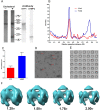Architecture of the Synaptophysin/Synaptobrevin Complex: Structural Evidence for an Entropic Clustering Function at the Synapse
- PMID: 26333660
- PMCID: PMC4558601
- DOI: 10.1038/srep13659
Architecture of the Synaptophysin/Synaptobrevin Complex: Structural Evidence for an Entropic Clustering Function at the Synapse
Abstract
We have purified the mammalian synaptophysin/synaptobrevin (SYP/VAMP2) complex to homogeneity in the presence of cholesterol and determined the 3D EM structure by single particle reconstruction. The structure reveals that SYP and VAMP2 assemble into a hexameric ring wherein 6 SYP molecules bind 6 VAMP2 dimers. Using the EM map as a constraint, a three dimensional atomic model was built and refined using known atomic structures and homology modeling. The overall architecture of the model suggests a simple mechanism to ensure cooperativity of synaptic vesicle fusion by organizing multiple VAMP2 molecules such that they are directionally oriented towards the target membrane. This is the first three dimensional architectural data for the SYP/VAMP2 complex and provides a structural foundation for understanding the role of this complex in synaptic transmission.
Figures




References
Publication types
MeSH terms
Substances
Grants and funding
LinkOut - more resources
Full Text Sources
Other Literature Sources

